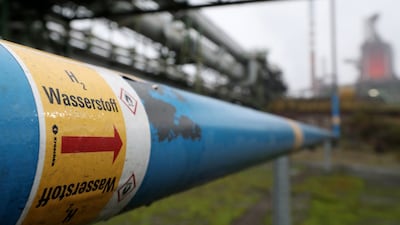S&P Global Platts, a commodities intelligence platform, unveiled the Middle East's first suite of prices to track the daily cost of hydrogen production.
One of the lightest and most abundant elements in the universe, hydrogen is being prioritised for development in the Middle East as a viable alternative fuel.
The element, which can be produced with carbon and non-carbon forms of energy, can be used in heavy transport and to decarbonise the power sector.
The new suite of prices will cover hydrogen produced through proton exchange membrane electrolysis, alkaline electrolysis and steam methane reforming with carbon capture and sequestration.
Platts will cover the production of hydrogen in Saudi Arabia, Oman, Qatar and the UAE.
“Huge amounts of capital are being invested in hydrogen production in the Middle East and the projects under development will put the region at the centre of the emerging hydrogen economy,” said Alan Hayes, head of energy transition pricing at S&P Global Platts.
“The Middle East has the potential to become a global supply hub for hydrogen in much the same way as it is now for crude oil.”
Including the region in Platts' global coverage of hydrogen production will help producers and consumers to track the cost of producing the fuel.
More importantly, it will also "compare the costs of producing with other hydrogen production hubs around the world”, Mr Hayes said.
Hydrogen is on track to become a multibillion-dollar industry in the Middle East, with total announced investments set to hit $44 billion, according to Platts' estimates.
About $35bn of the commitments will be in projects that will become operational by 2030.
The UAE committed to achieving net zero emissions by the middle of the century, as part of its nationally determined contributions tabled before the Cop26 climate summit held in Glasgow, Scotland, earlier this month.
The country will also host Cop28 in 2023 as it aims to take the lead in the region's energy transition.
In line with its net zero initiatives, the UAE plans to invest $160bn over the next three decades to hasten renewable energy development. Hydrogen has been earmarked for further development in the UAE and Saudi Arabia as a viable clean fuel.
Under the new suite of prices, the production of hydrogen through steam methane reforming in the region is cost-competitive.
The product, more commonly known as blue hydrogen, is produced when natural gas is heated with steam to produce carbon monoxide and hydrogen. Associated carbon dioxide is captured and stored to make the process low carbon.
The current prices for blue hydrogen in the UAE and Saudi Arabia are $5.60 a kilogram and $5.50 a kilogram, respectively, according to Platts.
Prices for the commodity in key global producers in Western Australia and Europe, specifically the Netherlands, average $5.95 a kilogram and 5.70 a kilogram, respectively.
Gulf energy companies such as Adnoc and Saudi Aramco have announced plans to develop blue hydrogen.
Adnoc is building a blue ammonia plant through its Fertiglobe joint venture with OCI at its Ruwais chemicals centre in Abu Dhabi. The plant will have a production capacity of 1,000 kilotonnes a year when completed.
Ammonia is a carrier fuel and the easiest way to transport hydrogen.
Hydrogen produced from electrolysis, which involves splitting water molecules into hydrogen and oxygen, is cheaper in Australia than in the UAE, Saudi Arabia or the US Gulf Coast, according to Platts.
Hydrogen produced through alkaline and PEM electrolysis is twice as expensive to produce in the UAE compared with Western Australia, where it costs $2.11 and $3.39 per kilogram, respectively.
“These latest costs of production assessments indicate that different production routes may favour different regions when it comes to establishing global hydrogen trade routes,” Platts said.


